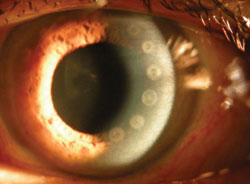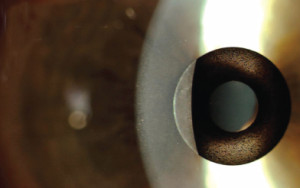Kamra corneal inlay by AcuFocus, Inc.
Some things in life are annoying and unavoidable, reading glasses certainly fall into that category…
Up to this point, there really has not been a surefire, surgical way to fix the near problems associated with presbyopia or the “Curse of the 40s.”
 Conductive Keratoplasty (pictured left) was a procedure that was done in the past by making thermal burns in a circular pattern on the cornea… this was pretty much a resounding failure and this procedure is rarely performed anymore.
Conductive Keratoplasty (pictured left) was a procedure that was done in the past by making thermal burns in a circular pattern on the cornea… this was pretty much a resounding failure and this procedure is rarely performed anymore.
Another option was and still is LASIK. Near vision with LASIK is achieved by surgically inducing monovision, where one eye is corrected for distance and the other for up close. Think of it like the 21st century version of the monocle and is commonly done with contact lenses. This is an effective correction option but tends to become less useful for near vision over time.
The best surgical option currently available is doing cataract surgery and putting in a lens that can actually focus for distance AND up close. Cataract surgery without a actual cataract is considered a cosmetic, out-of-pocket cost by insurance companies. With the add on cost of a couple of these high tech lenses, the price tag quickly becomes cost prohibitive to many individuals.
Introducing Corneal Inlays
 Corneal inlays are small pieces of plastic that are installed inside a pocket in the cornea. The pocket is created with the same laser that is also used to make the “flap” during LASIK surgery. The inlay is slid into the pocket, positioned correctly, and then the pocket seals itself.
Corneal inlays are small pieces of plastic that are installed inside a pocket in the cornea. The pocket is created with the same laser that is also used to make the “flap” during LASIK surgery. The inlay is slid into the pocket, positioned correctly, and then the pocket seals itself.
There are several cornea inlays used for presbyopic correction overseas and in Canada and a couple are slugging through the FDA approval process in the US.
The one most likely to be available to bifocal wearing Americans in the near future is the Kamra inlay by AcuFocus, INC.
The Kamra corneal inlay (shown above) is about 1/5 of the size of a contact lens and is implanted into only one eye. This plastic inlay has one central hole and over 8,000 tiny holes in the plastic to allow nutrients to flow through.
This device works by using the pinhole effect. Not to get too far into the weeds here, but if you every played with a pinhole camera as a child, or are familiar with photography, you know that making a smaller opening (or f-stop) on a camera increases the depth of focus. The Kamra corneal inlay only allows light to pass through a very small 1.6mm central hole and not through the normal pupil size which ranges from 3-7 mm. This greatly increases the available ranges that the human eye can focus on, particular with reading and computer tasks.
Since this device is positioned over the pupil, it is invisible to the naked eye. The video below shows several different patients with the kamra corneal inlay. It also does not effect the distance vision but allows for some additional vision for near tasks without reading glasses or bifocals. Unlike the other surgical options discussed above, this inlay can also be removed if treatment is not effective.
https://www.youtube.com/watch?v=GKECqj0JiDQ
This product is still in the investigatory stage and will likely not be available to patients (outside of research centers) until 2016 or later. For more information please visit the AcuFocus, Inc website about the Kamra corneal inlay.
We hope you have enjoyed this walk-through of a new technology you may be offered in the future and we will continue to keep you informed of any new or interesting advancements as we keep an Eye to the Future.
Take care of those eyeballs!
– Nick Wolf, OD


